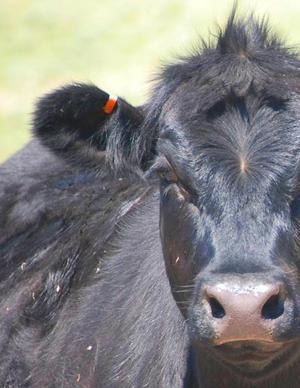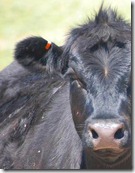Washington, D.C. —
Official exclusion of brands and eventual inclusion of feeder cattle continues to raise hackles in some quarters as the U.S. Department of Agriculture moves forward with a long-awaited plan to trace U.S. livestock moving into interstate commerce for disease mitigation purposes.
Secretary of Agriculture Tom Vilsack and the nation’s chief veterinary officer John Clifford held a press conference in Washington D.C. Tuesday and presided over a conference call with stakeholders to announce official publication of the animal disease traceability rule in Thursday’s Federal Register. Comments on the proposal will be accepted through Nov. 9.
Will hot-iron brands continue to be a widely accepted mode of cattle identification under the new rule?
It depends on whom you ask.
USDA officials went to great lengths to emphasize their support for the use of brands to satisfy the new requirements.
Still, brands would not appear on USDA’s list of official identifiers and that left some observers disappointed.
“They’ve tried to soften the blow about the brand issue for the last six weeks or so, but certainly none of that changed anything about how they appear to intend to implement this,” said John Reid, a rancher from Ordway, Colo.
Under the proposed rule, brands would not be included in a federal list of official ID methods or devices, but states and tribes would be free to form agreements permitting their use as an alternative, along with tattoos and breed registry certificates. The official ID would be low-cost metal ear tags, similar to the brucellosis tags ranchers have used for decades to identify breeding heifers vaccinated for that disease.
Dave Fly, New Mexico’s State Veterinarian, said the apparent change in status of brands from official to unofficial was significant. “It is a big deal if you get into a legal conflict, and you have no legs to stand on. We’re wondering why they decided to take it out,” Fly said from his office in Albuquerque.
He added that the rule “pre-empts” states by imposing certain requirements even before an outbreak occurs, a “concerning step,” and that the metal clip tags are not a good choice for ID purposes because of the amount of time involved in reading them.
“We’ve gone low-tech, but it’s high maintenance,” he said.
Another aspect that rankled some was how USDA planned to phase in feeder cattle. In the initial phase, official identification would apply only to breeding cattle, dairy cattle and animals being moved across state lines for rodeo or recreational events, shows or exhibitions. Feeder cattle would be exempt until sufficient benchmarks of participation had been reached, with that threshold proposed at 70 percent.
Some think that number is too low.
The rule does allow use of USDA-approved backtags, at least in the initial stages, for cattle and bison moving directly to slaughter or through one approved livestock facility before going to slaughter. That measure was of particular concern to livestock marketers, who didn’t want to see older, weaker cattle run through a chute any more than necessary.
The cost of stressing livestock with additional handling ultimately gets passed back to the producer through the loss of value.
“A lot of old cows can’t stand that extra processing,” Reid noted.
Richard Bowman, a cattle producer and veterinarian from Rhame, S.D., said he could see both sides of the issue: the need to make disease exposure easier to track for regulatory veterinarians and the concern by producers of “having more hoops to jump through.”
Like most of the groups that released initial statements, he thought federal officials had done a pretty good job of balancing those two considerations and including the industry in the rule-making process.
“I think they are being as easy as they can be and still get something done,” he said. “If we make an attempt to identify everything, enough of the ear clips will stay in to do a lot better job of tracking these animals when we need to.”
He and a brother raise cattle in two different states but use the same brand. If a diseased animal showed up at a slaughter location, a numbered ear tag might prevent one of their two herds from being tested, he explained. A brand, on the other hand, would leave trace-back to the home herd more difficult, he said.
In his initial reading of the 114-page proposal, Bowman said he didn’t see anything to trigger “serious opposition” to the plan, although he did say two items he would be watching closely included the timing for adding feeder cattle into the mandate and whether the industry would be sufficiently prepared to include them.
Likewise, while most groups said they would be analyzing the plan carefully in the days and weeks to come, they were generally positive in their initial responses.
Jess Peterson, a Montana rancher now based in Washington as executive vice president of the U.S. Cattlemen’s Association, said the announcement came without any big surprises. “We’ve been talking about this for over a decade,” he said by phone. “I don’t think we’re at risk of running too fast on this thing.”
One group that did come out swinging was R-CALF USA.
In a news release, R-CALF accused the ag department of “spurning” cattle producers and directly defying them by producing a proposal that was “over-reaching” and “intrusive.”
The group’s current president, George Chambers, who runs a diversified cattle operation based in Carrollton, Ga., said two provisions — delisting brands as official ID and including feeder cattle in the program — went too far.
“USDA did not have to attack our industry’s hot-iron brand or add younger cattle to the proposed rule in order to improve animal disease traceability in the United States, but we believe it has chosen to do so to appease the World Trade Organization and other international tribunals,” he said.
Secretary Vilsack said as much at his D.C. press conference, emphasizing that the program would improve the country’s ability to market livestock and related products overseas.
While the rule will only apply to cattle moving into interstate commerce, nearly all producers sell into interstate commerce at some point, if only when they cull old cows or other low performing animals from their herd. Consolidation of processing and feeding facilities also forces most cattle to move across state lines.
Reid compared the tracking mandate to recently proposed transportation rules that would have required farmers to meet the same regulatory obligations as commercial truckers, a prospect that raised alarm throughout the industry before being dropped by the Department of Transportation.
“The government intrudes on us by continually expanding the commerce clause,” he said.
http://www.agjournalonline.com/news/facebook/x386654954/Livestock-tracking-plan-moves-forward


Deprecated: strpos(): Passing null to parameter #1 ($haystack) of type string is deprecated in /home/agriviek8Qv/agriviet.net/public_html/wp-includes/comment-template.php on line 2522